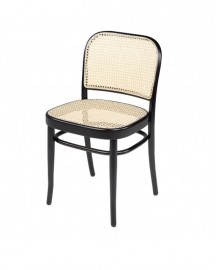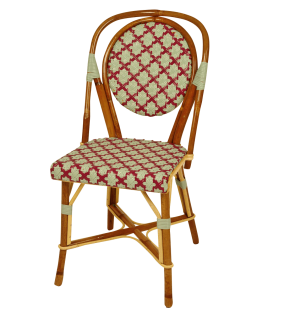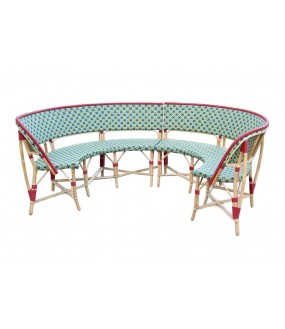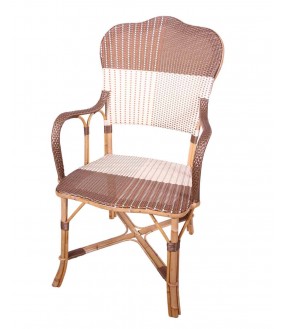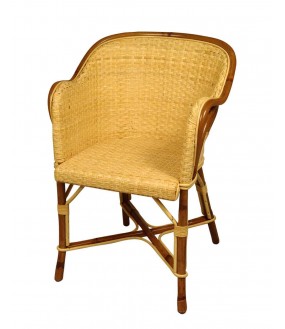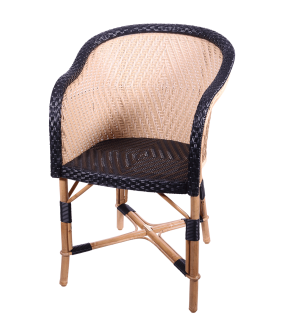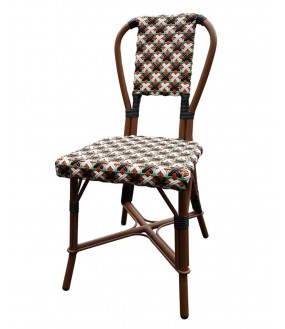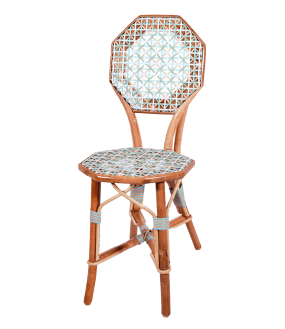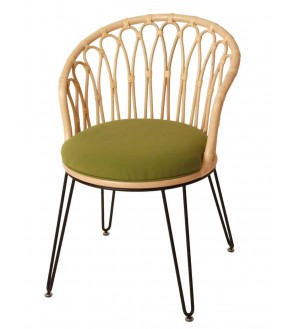Custom Made Dining Chair

-
Dining Chair Opus Mid Century Design
Opus is a fanciful dining chair full of luxurious features.
Its distinctive open curved back is extremely sculptured and it contrasts with the slim legs made of polished brass.
It is upholstered in velvet and has mixed tones both on the back and the round cushioned pad.
-
Dining Chair Pepe, Made On Order
The Pepe chair. A chair exclusively made to order and entirely by hand. Beautiful chair made of lacquered black beech with Pepe Peñalver fabric seat and caned backrest. Very nice structure made of wood. This chair is designed exclusively for indoor use.
-
Thonet Style Chair Edgard, Made To Order
€550.01The Edgard black chair in the Thonet style. Beautiful chair made of lacquered black beech and sitting in cane. A chair made entirely on order and by hand. This chair is designed for indoor use. Beyond its singular beauty, the Edgard chair is very comfortable, light and very resistant thanks to the beech wood which is the most resistant wood for furniture. Ideal with a raw wood or marble table.
-
Dining Chair Pepe, Made On Order
The dining chair Pepe is available in a wide range of colors or printed fabrics. Look at the photos and contact us to confirm your choice.
Very beautiful chair made of black beech with its rectangular backrest in natural white cane.
Very nice structure made of wood.
This chair is designed exclusively for indoor use.
Beyond its singular beauty, the Pepe chair is very comfortable, light and very resistant thanks to the use of beech, which is the most resistant type of wood for the manufacture of furniture.
This classy chair will undoubtedly embellish your kitchen, living room, conservatory or restaurant.
Ideal around a raw wood or marble dining table.
Minimum order: 2 pieces.
-
Ava II Bar Chair
Refined bar chair in velvet fabric, ebony needle foot and brass.
Chair majestic bar and exquisite refinement.
A decorative element to be placed in front of a lounge bar or an hotel bar to create a warm and cozy atmosphere.
-
Magnificent Rattan Chair, Made on Order
€1,398.00Superb handcrafted rattan chair, made on demand.
This cane chair is ideal for your terrace, in your garden but also for your interior.
Very comfortable, this exceptional rattan chair is light and very resistant.
This chair will beautify your living room, your kitchen, your terrace, your veranda or your restaurant.
A magnificent French craftsmanship, this chair is entirely handmade.
Type: chair with wide seat 43cm
Stackability: Not stackable
Indoor/Outdoor: Indoor, Outdoor friendly
Fiber: Satin (Raucord)
Structure materials: Dark rattan (Malacca)
Weaving range: exceptions
Colours: Satin Beige – Pantone 7502, Satin Ultramarine Blue – Pantone 534, Satin Royal Blue, Satin Terracotta, Satin Olive Green – Pantone 5743
Seat height: 45cm
Seat width: Wide seat
Overall height: 81cm
Overall width: 58cm
Overall depth: 63cm
Weight: 7kg
Varnish and paint: Varnish
Rattan, a material with extraordinary properties with limits.
Rattan is a vine of the Palm race, which grows in very humid or even swampy equatorial forests.
With its siliceous skin like glass, this extremely solid and light vine is particularly resistant to humidity, as are tropical woods, teak or others.
But this resistance has its limits. Exposed to rain, rattan resists very well for a whole day or even a few days. But if this rain continues for too many hours, the humidity will gradually penetrate the Rattan, and day after day the material kept damp will end up slowly degrading and losing its resistance qualities.
The physical limits of rattan imply precautions for use. On the terraces of Parisian cafes, the chairs can last for decades while they are often in the rain all day for long periods. But they are piled up every night under cover and can thus dry out.
More generally, rattan can withstand rain for long hours without compromising its longevity, but must be able to dry regularly.
In practice, rattan furniture can stay outside throughout the "summer season", the weather is hot and rather dry, continuous rains exceptionally last more than three or four days and Rattan withstands such rains without degrading.
But as soon as the season advances, the temperature drops, there is a lot of condensation and humidity, the Rattan will gradually become humid, the long and heavy rains accentuating this degradation. In practice, these are sensitive situations by the sea.
It is then imperative to put the seats under shelter, a ventilated shelter to avoid progressive humidification as soon as the "bad season" arrives, in practice from mid-October to mid-March for a continental climate.
The alternative if you want to use your Rattan furniture all year round, is to put it away daily, every evening, as Parisian terraces do.
In summary, 2 main principles to respect:
During the winter season (October 15 to March 15 in Europe) in all climates: the furniture must be stored “dry”. It can however be left outside during the day, but must imperatively be put in the dry during the night.
During the "beautiful season", the rest of the time, the Rattan can remain permanently outside.
However, if a lasting rain arrives, the Rattan should only be left in this rain for two or three days at the most, before putting the furniture in the dry place so that it can dry. He only takes it out once the rain has stopped (In any case, a terrace cannot be used in the rain).
-
Rattan Medallion Chair, Made on Demand
€1,128.00The rattan medallion chair. Superb handcrafted rattan chair, made on demand.
Price upon request.
This cane chair is ideal for your terrace, in your garden but also for your interior.
Very comfortable, the Anatole chair is light and very resistant.
This chair will beautify your living room, your kitchen, your terrace, your veranda or your restaurant.
A magnificent French craftsmanship, the Anatole chair is entirely handmade.
Type: chair with wide seat 43cm
Stackability: stackable
Indoor/Outdoor: Semi-outdoor
Fiber: Brilliant (Rilsan)
Colours: Gloss Bordeaux, Gloss Yellow, Gloss Putty
Structure materials: Dark rattan (Malacca)
Weaving range: prestige
Colours: Brilliant Burgundy – Pantone 188, Jade Green – Pantone 556, Brilliant Mint Green – Pantone 5787
Seat height: 45cm
Overall height: 87cm
Overall width: 50cm
Overall depth: 45cm
Weight: 5kg
Varnish and paint: Varnish
Rattan, a material with extraordinary properties with limits.
Rattan is a vine of the Palm race, which grows in very humid or even swampy equatorial forests.
With its siliceous skin like glass, this extremely solid and light vine is particularly resistant to humidity, as are tropical woods, teak or others.
But this resistance has its limits. Exposed to rain, rattan resists very well for a whole day or even a few days. But if this rain continues for too many hours, the humidity will gradually penetrate the Rattan, and day after day the material kept damp will end up slowly degrading and losing its resistance qualities.
The physical limits of rattan imply precautions for use. On the terraces of Parisian cafes, the chairs can last for decades while they are often in the rain all day for long periods. But they are piled up every night under cover and can thus dry out.
More generally, rattan can withstand rain for long hours without compromising its longevity, but must be able to dry regularly.
In practice, rattan furniture can stay outside throughout the "summer season", the weather is hot and rather dry, continuous rains exceptionally last more than three or four days and Rattan withstands such rains without degrading.
But as soon as the season advances, the temperature drops, there is a lot of condensation and humidity, the Rattan will gradually become humid, the long and heavy rains accentuating this degradation. In practice, these are sensitive situations by the sea.
It is then imperative to put the seats under shelter, a ventilated shelter to avoid progressive humidification as soon as the "bad season" arrives, in practice from mid-October to mid-March for a continental climate.
The alternative if you want to use your Rattan furniture all year round, is to put it away daily, every evening, as Parisian terraces do.
In summary, 2 main principles to respect:
During the winter season (October 15 to March 15 in Europe) in all climates: the furniture must be stored “dry”. It can however be left outside during the day, but must imperatively be put in the dry during the night.
During the "beautiful season", the rest of the time, the Rattan can remain permanently outside.
However, if a lasting rain arrives, the Rattan should only be left in this rain for two or three days at the most, before putting the furniture in the dry place so that it can dry. He only takes it out once the rain has stopped (In any case, a terrace cannot be used in the rain).
En savoir plus sur ce texte sourceVous devez indiquer le texte source pour obtenir des informations supplémentaires
Envoyer des commentaires
Panneaux latéraux
-
Superb Rattan Half Moon Bench, Made to Order
Superb bench in the shape of a half moon in woven rattan is made exclusively to measure. This magnificent bench will contribute to the general atmosphere of your interior or exterior ambiance.
Handcrafted rattan bench, made to order.
Price upon request.
This marvelous cane bench is ideal for your terrace, in your garden but also for your interior.
Very comfortable, this bench is light and very resistant.
A magnificent French craftsmanship, the Guinguette bench is entirely handmade.
Custom seat.
Stackability: not stackable
Indoor/Outdoor: Semi-outdoor
Fiber: Brilliant (Rilsan)
Colours: Gloss Bordeaux, Gloss Yellow, Gloss Putty
Structure materials: Light rattan (Manila)
Weaving range: prestige
Seat height: 45cm
Overall height: custom
Overall width: custom
Overall depth: custom
Varnish and paint: Varnish
Rattan, a material with extraordinary properties with limits.
Rattan is a vine of the Palm race, which grows in very humid or even swampy equatorial forests.
With its siliceous skin like glass, this extremely solid and light vine is particularly resistant to humidity, as are tropical woods, teak or others.
But this resistance has its limits. Exposed to rain, rattan resists very well for a whole day or even a few days. But if this rain continues for too many hours, the humidity will gradually penetrate the Rattan, and day after day the material kept damp will end up slowly degrading and losing its resistance qualities.
The physical limits of rattan imply precautions for use. On the terraces of Parisian cafes, the chairs can last for decades while they are often in the rain all day for long periods. But they are piled up every night under cover and can thus dry out.
More generally, rattan can withstand rain for long hours without compromising its longevity, but must be able to dry regularly.
In practice, rattan furniture can stay outside throughout the "summer season", the weather is hot and rather dry, continuous rains exceptionally last more than three or four days and Rattan withstands such rains without degrading.
But as soon as the season advances, the temperature drops, there is a lot of condensation and humidity, the Rattan will gradually become humid, the long and heavy rains accentuating this degradation. In practice, these are sensitive situations by the sea.
It is then imperative to put the seats under shelter, a ventilated shelter to avoid progressive humidification as soon as the "bad season" arrives, in practice from mid-October to mid-March for a continental climate.
The alternative if you want to use your Rattan furniture all year round, is to put it away daily, every evening, as Parisian terraces do.
In summary, 2 main principles to respect:
During the winter season (October 15 to March 15 in Europe) in all climates: the furniture must be stored “dry”. It can however be left outside during the day, but must imperatively be put in the dry during the night.
During the "beautiful season", the rest of the time, the Rattan can remain permanently outside.
However, if a lasting rain arrives, the Rattan should only be left in this rain for two or three days at the most, before putting the furniture in the dry place so that it can dry. He only takes it out once the rain has stopped (In any case, a terrace cannot be used in the rain).
En savoir plus sur ce texte sourceVous devez indiquer le texte source pour obtenir des informations supplémentaires
Envoyer des commentaires
Panneaux latéraux
-
Large Cane Rattan Armchair, Made On Order
€1,360.00Superb handcrafted armchair in woven rattan.
This cane rattan armchair with natural slat underlined with tinted slat naturally finds its place as a garden armchair, living room armchair in town, veranda armchair facing the sea.
This chair must be protected from the rain.
Manufacturing on demand.
Welcoming with its fully woven backrest and its generous shapes, this armchair is a restaurant armchair, in the colors of your desires, non-stackable, and is as beautiful inside as it is outside.
Very comfortable, this cane rattan armchair is light and very resistant.
A magnificent French craftsmanship, this armchair is entirely handmade.
Type: chair with wide seat 43cm
Stackability: Not stackable
Indoor/Outdoor: Semi-Outdoor
Fiber: Satin (Raucord)
Colours: Satin Chocolate – Pantone 476, Satin Ivory – Pantone 7506, Satin Terracotta
Structure materials: Light rattan (Manila)
Weaving range: Classic
Seat height: 45cm
Seat width: Wide seat (43 cm).
Overall height: 102cm
Overall width: 61cm
Overall depth: 63cm
Weight: 7kg
Varnish and paint: Varnish
Rattan, a material with extraordinary properties with limits.
Rattan is a vine of the Palm race, which grows in very humid or even swampy equatorial forests.
With its siliceous skin like glass, this extremely solid and light vine is particularly resistant to humidity, as are tropical woods, teak or others.
But this resistance has its limits. Exposed to rain, rattan resists very well for a whole day or even a few days. But if this rain continues for too many hours, the humidity will gradually penetrate the Rattan, and day after day the material kept damp will end up slowly degrading and losing its resistance qualities.
The physical limits of rattan imply precautions for use. On the terraces of Parisian cafes, the chairs can last for decades while they are often in the rain all day for long periods. But they are piled up every night under cover and can thus dry out.
More generally, rattan can withstand rain for long hours without compromising its longevity, but must be able to dry regularly.
In practice, rattan furniture can stay outside throughout the "summer season", the weather is hot and rather dry, continuous rains exceptionally last more than three or four days and Rattan withstands such rains without degrading.
But as soon as the season advances, the temperature drops, there is a lot of condensation and humidity, the Rattan will gradually become humid, the long and heavy rains accentuating this degradation. In practice, these are sensitive situations by the sea.
It is then imperative to put the seats under shelter, a ventilated shelter to avoid progressive humidification as soon as the "bad season" arrives, in practice from mid-October to mid-March for a continental climate.
The alternative if you want to use your Rattan furniture all year round, is to put it away daily, every evening, as Parisian terraces do.
In summary, 2 main principles to respect:
During the winter season (October 15 to March 15 in Europe) in all climates: the furniture must be stored “dry”. It can however be left outside during the day, but must imperatively be put in the dry during the night.
During the "beautiful season", the rest of the time, the Rattan can remain permanently outside.
However, if a lasting rain arrives, the Rattan should only be left in this rain for two or three days at the most, before putting the furniture in the dry place so that it can dry. He only takes it out once the rain has stopped (In any case, a terrace cannot be used in the rain).
En savoir plus sur ce texte sourceVous devez indiquer le texte source pour obtenir des informations supplémentaires
Envoyer des commentaires
Panneaux latéraux
-
Folding Rattan Chair, 4 colors available
€540.00The rattan and steel folding chair.
Very beautiful handcrafted chair in rattan and metal structure.
Available from stock. A limited series.
Sturdy and lightweight stackable furniture.
This cane chair is ideal for your terrace, in your garden but also for your interior.
Comfortable, this woven fiber chair is light and very resistant.
This chair will beautify your living room, your kitchen, your terrace, your veranda or your restaurant.
A beautiful French craftsmanship, this folding chair is entirely handmade.
Seat width: 39cm
Stackability: stackable
Indoor/Outdoor: Semi-Outdoor
Fiber: Satin (Raucord)
Structure materials: Steel, Marine plywood
Weaving range: classic
Seat height: 45cm
Overall height: 90cm
Overall width: 40cm
Overall depth: 50cm
Weight: 5kg
Varnish and paint: Varnish
Rattan, a material with extraordinary properties with limits.
Rattan is a vine of the Palm race, which grows in very humid or even swampy equatorial forests.
With its siliceous skin like glass, this extremely solid and light vine is particularly resistant to humidity, as are tropical woods, teak or others.
But this resistance has its limits. Exposed to rain, rattan resists very well for a whole day or even a few days. But if this rain continues for too many hours, the humidity will gradually penetrate the Rattan, and day after day the material kept damp will end up slowly degrading and losing its resistance qualities.
The physical limits of rattan imply precautions for use. On the terraces of Parisian cafes, the chairs can last for decades while they are often in the rain all day for long periods. But they are piled up every night under cover and can thus dry out.
More generally, rattan can withstand rain for long hours without compromising its longevity, but must be able to dry regularly.
In practice, rattan furniture can stay outside throughout the "summer season", the weather is hot and rather dry, continuous rains exceptionally last more than three or four days and Rattan withstands such rains without degrading.
But as soon as the season advances, the temperature drops, there is a lot of condensation and humidity, the Rattan will gradually become humid, the long and heavy rains accentuating this degradation. In practice, these are sensitive situations by the sea.
It is then imperative to put the seats under shelter, a ventilated shelter to avoid progressive humidification as soon as the "bad season" arrives, in practice from mid-October to mid-March for a continental climate.
The alternative if you want to use your Rattan furniture all year round, is to put it away daily, every evening, as Parisian terraces do.
In summary, 2 main principles to respect:
During the winter season (October 15 to March 15 in Europe) in all climates: the furniture must be stored “dry”. It can however be left outside during the day, but must imperatively be put in the dry during the night.
During the "beautiful season", the rest of the time, the Rattan can remain permanently outside.
However, if a lasting rain arrives, the Rattan should only be left in this rain for two or three days at the most, before putting the furniture in the dry place so that it can dry. He only takes it out once the rain has stopped (In any case, a terrace cannot be used in the rain).
En savoir plus sur ce texte sourceVous devez indiquer le texte source pour obtenir des informations supplémentaires
Envoyer des commentaires
Panneaux latéraux
-
Large Rattan Armchair Vintage Style 1900's
€800.00Imposing armchair in vintage style but light, entirely woven with natural lamina, it can be woven "to measure" in synthetic fibre.
Available from stock, price on request.
This natural fiber armchair.
This large rattan armchair will embellish your kitchen, your living room, your terrace, your veranda or your restaurant.
Overall height: 80cm
Overall width: 64cm
Overall depth: 62cm
Weight: 7kg
Seat height: 45cm
Seat width: 43 cm wide seat
Indoor/Outdoor: Indoor (this furniture must absolutely remain dry.)
Colors: Cannage Natural blade
Stackability: Not stackable
Material: Light Rattan (Manila)
Fiber: Natural Blade
Finish: Glossy varnish
Possibility of weaving the Cruise line armchair in your colors, a made-to-measure production with the color of caning and the weaving of your choice (see photos).
Rattan, a material with extraordinary properties with limits. Rattan is a vine of the Palm race, which grows in very humid or even swampy equatorial forests.
With its siliceous skin like glass, this extremely solid and light vine is particularly resistant to humidity, as are tropical woods, teak or others.
But this resistance has its limits. Exposed to rain, rattan resists very well for a whole day or even a few days. But if this rain continues for too many hours, the humidity will gradually penetrate the Rattan, and day after day the material kept damp will end up slowly degrading and losing its resistance qualities.
The physical limits of rattan imply precautions for use. On the terraces of Parisian cafes, the chairs can last for decades while they are often in the rain all day for long periods. But they are piled up every night under cover and can thus dry out.
More generally, rattan can withstand rain for long hours without compromising its longevity, but must be able to dry regularly.
In practice, rattan furniture can stay outside throughout the "summer season", the weather is hot and rather dry, continuous rains exceptionally last more than three or four days and Rattan withstands such rains without degrading.
But as soon as the season advances, the temperature drops, there is a lot of condensation and humidity, the Rattan will gradually become humid, the long and heavy rains accentuating this degradation. In practice, these are sensitive situations by the sea.
It is then imperative to put the seats under shelter, a ventilated shelter to avoid progressive humidification as soon as the "bad season" arrives, in practice from mid-October to mid-March for a continental climate.
The alternative if you want to use your Rattan furniture all year round, is to put it away daily, every evening, as Parisian terraces do.
In summary, 2 main principles to respect:
During the winter season (October 15 to March 15 in Europe) in all climates: the furniture must be stored “dry”. It can however be left outside during the day, but must imperatively be put in the dry during the night.
During the "beautiful season", the rest of the time, the Rattan can remain permanently outside.
However, if a lasting rain arrives, the Rattan should only be left in this rain for two or three days at the most, before drying the furniture to
so that it can dry out. He only takes it out once the rain has stopped (In any case, a terrace cannot be used in the rain).
-
Beige Rattan Armchair, Vintage Style
€900.00Imposing vintage 1900 style armchair but light (7kg), entirely woven with natural blade, it can be woven "to measure" in synthetic fiber.
Available from stock.
This natural fiber armchair must be protected from the rain.
This large rattan armchair will embellish your kitchen, your living room, your terrace, your veranda or your restaurant.
Overall height: 78cm
Overall width: 75cm
Overall depth: 53cm
Weight: 7kg
Seat height: 45cm
Height of the armrests: 72 cm
Seat width: 43 cm wide seat
Indoor/Outdoor: Semi-Outdoor
Colours: Satin beige – Pantone 7502, Satin black – Pantone Black C
Stackability: Not stackable
Weaving fibers: Satin (Raucord)
Finish: Varnish
Structure materials: Light rattan (Manila)
Rattan is a material with extraordinary properties with limits. Rattan is a vine of the Palm race, which grows in very humid or even swampy equatorial forests.
With its siliceous skin like glass, this extremely solid and light vine is particularly resistant to humidity, as are tropical woods, teak or others.
But this resistance has its limits. Exposed to rain, rattan resists very well for a whole day or even a few days. But if this rain continues for too many hours, the humidity will gradually penetrate the Rattan, and day after day the material kept damp will end up slowly degrading and losing its resistance qualities.
The physical limits of rattan imply precautions for use. On the terraces of Parisian cafes, the chairs can last for decades while they are often in the rain all day for long periods. But they are piled up every night under cover and can thus dry out.
More generally, rattan can withstand rain for long hours without compromising its longevity, but must be able to dry regularly.
In practice, rattan furniture can stay outside throughout the "summer season", the weather is hot and rather dry, continuous rains exceptionally last more than three or four days and Rattan withstands such rains without degrading.
But as soon as the season advances, the temperature drops, there is a lot of condensation and humidity, the Rattan will gradually become humid, the long and heavy rains accentuating this degradation. In practice, these are sensitive situations by the sea.
It is then imperative to put the seats under shelter, a ventilated shelter to avoid progressive humidification as soon as the "bad season" arrives, in practice from mid-October to mid-March for a continental climate.
The alternative if you want to use your Rattan furniture all year round, is to put it away daily, every evening, as Parisian terraces do.
In summary, 2 main principles to respect:
During the winter season (October 15 to March 15 in Europe) in all climates: the furniture must be stored “dry”. It can however be left outside during the day, but must imperatively be put in the dry during the night.
During the "beautiful season", the rest of the time, the Rattan can remain permanently outside.
However, if a lasting rain arrives, the Rattan should only be left in this rain for two or three days at the most, before putting the furniture in the dry place so that it can dry. He only takes it out once the rain has stopped (In any case, a terrace cannot be used in the rain).
-
Prestigious Rattan Chair, Made On Demand
Superb handcrafted rattan chair, made on demand.
Chair available in several colors: ask us.
Sturdy and lightweight stackable furniture.
This cane chair is ideal for your terrace, in your garden but also for your interior.
Very comfortable, this elegant rattan chair is light and very resistant.
This chair will beautify your living room, your kitchen, your terrace, your veranda or your restaurant.
A magnificent French craftsmanship, entirely handmade.
Seat width: wide 43 cm
Stackability: stackable
Indoor/Outdoor: Outdoor
Fiber: Satin (Raucord)
Colours: Satin white, Satin soft blue – Pantone 5493, Satin black – Pantone Black C, Satin orange.
Structure materials: Aluminum
Weaving range: prestige
Seat height: 45cm
Overall height: 84cm
Overall width: 40cm
Overall depth: 45cm
Weight: 5kg
Varnish and paint: powder coating
Rattan, a material with extraordinary properties with limits.
Rattan is a vine of the Palm race, which grows in very humid or even swampy equatorial forests.
With its siliceous skin like glass, this extremely solid and light vine is particularly resistant to humidity, as are tropical woods, teak or others.
But this resistance has its limits. Exposed to rain, rattan resists very well for a whole day or even a few days. But if this rain continues for too many hours, the humidity will gradually penetrate the Rattan, and day after day the material kept damp will end up slowly degrading and losing its resistance qualities.
The physical limits of rattan imply precautions for use. On the terraces of Parisian cafes, the chairs can last for decades while they are often in the rain all day for long periods. But they are piled up every night under cover and can thus dry out.
More generally, rattan can withstand rain for long hours without compromising its longevity, but must be able to dry regularly.
In practice, rattan furniture can stay outside throughout the "summer season", the weather is hot and rather dry, continuous rains exceptionally last more than three or four days and Rattan withstands such rains without degrading.
But as soon as the season advances, the temperature drops, there is a lot of condensation and humidity, the Rattan will gradually become humid, the long and heavy rains accentuating this degradation. In practice, these are sensitive situations by the sea.
It is then imperative to put the seats under shelter, a ventilated shelter to avoid progressive humidification as soon as the "bad season" arrives, in practice from mid-October to mid-March for a continental climate.
The alternative if you want to use your Rattan furniture all year round, is to put it away daily, every evening, as Parisian terraces do.
In summary, 2 main principles to respect:
During the winter season (October 15 to March 15 in Europe) in all climates: the furniture must be stored “dry”. It can however be left outside during the day, but must imperatively be put in the dry during the night.
During the "beautiful season", the rest of the time, the Rattan can remain permanently outside.
However, if a lasting rain arrives, the Rattan should only be left in this rain for two or three days at the most, before putting the furniture in the dry place so that it can dry. He only takes it out once the rain has stopped (In any case, a terrace cannot be used in the rain).
-
Rattan Chair, Jade Color
€840.00The rattan chair with its square backrest. Superb handcrafted rattan chair, made on demand.
Price upon request.
This cane chair is ideal for your terrace, in your garden but also for your interior.
Very comfortable, this beautiful chair is light and very resistant.
This chair will beautify your living room, your kitchen, your terrace, your veranda or your restaurant.
A magnificent French artisanal achievement, entirely handmade.
Type: chair with wide seat 43cm
Stackability: stackable
Indoor/Outdoor: Semi-outdoor
Fiber: Brilliant (Rilsan)
Colours: Bright White, Bright Burgundy – Pantone 188, Jade Green – Pantone 556
Structure materials: Dark rattan (Malacca)
Weaving range: classic
Seat height: 45cm
Overall height: 79cm
Overall width: 40cm
Overall depth: 48cm
Weight: 5kg
Varnish and paint: Varnish
Rattan, a material with extraordinary properties with limits.
Rattan is a vine of the Palm race, which grows in very humid or even swampy equatorial forests.
With its siliceous skin like glass, this extremely solid and light vine is particularly resistant to humidity, as are tropical woods, teak or others.
But this resistance has its limits. Exposed to rain, rattan resists very well for a whole day or even a few days. But if this rain continues for too many hours, the humidity will gradually penetrate the Rattan, and day after day the material kept damp will end up slowly degrading and losing its resistance qualities.
The physical limits of rattan imply precautions for use. On the terraces of Parisian cafes, the chairs can last for decades while they are often in the rain all day for long periods. But they are piled up every night under cover and can thus dry out.
More generally, rattan can withstand rain for long hours without compromising its longevity, but must be able to dry regularly.
In practice, rattan furniture can stay outside throughout the "summer season", the weather is hot and rather dry, continuous rains exceptionally last more than three or four days and Rattan withstands such rains without degrading.
But as soon as the season advances, the temperature drops, there is a lot of condensation and humidity, the Rattan will gradually become humid, the long and heavy rains accentuating this degradation. In practice, these are sensitive situations by the sea.
It is then imperative to put the seats under shelter, a ventilated shelter to avoid progressive humidification as soon as the "bad season" arrives, in practice from mid-October to mid-March for a continental climate.
The alternative if you want to use your Rattan furniture all year round, is to put it away daily, every evening, as Parisian terraces do.
In summary, 2 main principles to respect:
During the winter season (October 15 to March 15 in Europe) in all climates: the furniture must be stored “dry”. It can however be left outside during the day, but must imperatively be put in the dry during the night.
During the "beautiful season", the rest of the time, the Rattan can remain permanently outside.
However, if a lasting rain arrives, the Rattan should only be left in this rain for two or three days at the most, before putting the furniture in the dry place so that it can dry. He only takes it out once the rain has stopped (In any case, a terrace cannot be used in the rain).
-
Elegant Rattan Chair, Made On Order
The Fleur rattan chair. Superb handcrafted rattan chair, made on demand.
Chair woven in your colors, sturdy and light stackable furniture.
This cane chair is ideal for your terrace, in your garden but also for your interior.
Very comfortable, the Fleur chair is light and very resistant.
This chair will beautify your living room, your kitchen, your terrace, your veranda or your restaurant.
A magnificent French craftsmanship, the Fleur chair is entirely handmade.
Seat width: custom
Stackability: Not stackable
Indoor/Outdoor: Indoor, Outdoor friendly
Fiber: Satin (Raucord)
Colours: Beige satin – Pantone 7502, White satin, Soft blue satin – Pantone 5493, Soft green satin – Pantone 557
Structure materials: Dark rattan (Malacca)
Weaving range: classic
Colours: Satin Beige – Pantone 7502, Satin Ultramarine Blue – Pantone 534, Satin Royal Blue, Satin Terracotta, Satin Olive Green – Pantone 5743
Seat height: 45cm
Seat width: Wide seat
Overall height: 85cm
Overall width: 35cm
Overall depth: 47cm
Weight: 5kg
Varnish and paint: Varnish
Rattan, a material with extraordinary properties with limits.
Rattan is a vine of the Palm race, which grows in very humid or even swampy equatorial forests.
With its siliceous skin like glass, this extremely solid and light vine is particularly resistant to humidity, as are tropical woods, teak or others.
But this resistance has its limits. Exposed to rain, rattan resists very well for a whole day or even a few days. But if this rain continues for too many hours, the humidity will gradually penetrate the Rattan, and day after day the material kept damp will end up slowly degrading and losing its resistance qualities.
The physical limits of rattan imply precautions for use. On the terraces of Parisian cafes, the chairs can last for decades while they are often in the rain all day for long periods. But they are piled up every night under cover and can thus dry out.
More generally, rattan can withstand rain for long hours without compromising its longevity, but must be able to dry regularly.
In practice, rattan furniture can stay outside throughout the "summer season", the weather is hot and rather dry, continuous rains exceptionally last more than three or four days and Rattan withstands such rains without degrading.
But as soon as the season advances, the temperature drops, there is a lot of condensation and humidity, the Rattan will gradually become humid, the long and heavy rains accentuating this degradation. In practice, these are sensitive situations by the sea.
It is then imperative to put the seats under shelter, a ventilated shelter to avoid progressive humidification as soon as the "bad season" arrives, in practice from mid-October to mid-March for a continental climate.
The alternative if you want to use your Rattan furniture all year round, is to put it away daily, every evening, as Parisian terraces do.
In summary, 2 main principles to respect:
During the winter season (October 15 to March 15 in Europe) in all climates: the furniture must be stored “dry”. It can however be left outside during the day, but must imperatively be put in the dry during the night.
During the "beautiful season", the rest of the time, the Rattan can remain permanently outside.
However, if a lasting rain arrives, the Rattan should only be left in this rain for two or three days at the most, before putting the furniture in the dry place so that it can dry. He only takes it out once the rain has stopped (In any case, a terrace cannot be used in the rain).
-
Round Rattan Chair w/ Metal Feet
€960.00The chair with a round seat, rattan backrest and metal legs.
Very beautiful handcrafted chair with a rattan backrest without weaving, an upholstered seat cushion and black-finish tubular metal legs.
Light and resistant, restaurant chair or kitchen chair.
Sturdy and lightweight non-stackable furniture.
A beautiful French craftsmanship, this folding chair is entirely handmade.
Overall width: 41 cm
Overall depth:
50cm
Overall height: 88cm
Seat width:
Wide seat (43cm), Standard seat (39cm)
Seat height :
45cm
Stackability:
Stackable
Availability: Made to order
Indoor/Outdoor: Semi-Outdoor
Colors:
Natural Fiber
Structure materials:
Steel, Light Rattan (Manila)
Weight: 5kg
Rattan, a material with extraordinary properties with limits.
Rattan is a vine of the Palm race, which grows in very humid or even swampy equatorial forests.
With its siliceous skin like glass, this extremely solid and light vine is particularly resistant to humidity, as are tropical woods, teak or others.
But this resistance has its limits. Exposed to rain, rattan resists very well for a whole day or even a few days. But if this rain continues for too many hours, the humidity will gradually penetrate the Rattan, and day after day the material kept damp will end up slowly degrading and losing its resistance qualities.
The physical limits of rattan imply precautions for use. On the terraces of Parisian cafes, the chairs can last for decades while they are often in the rain all day for long periods. But they are piled up every night under cover and can thus dry out.
More generally, rattan can withstand rain for long hours without compromising its longevity, but must be able to dry regularly.
In practice, rattan furniture can stay outside throughout the "summer season", the weather is hot and rather dry, continuous rains exceptionally last more than three or four days and Rattan withstands such rains without degrading.
But as soon as the season advances, the temperature drops, there is a lot of condensation and humidity, the Rattan will gradually become humid, the long and heavy rains accentuating this degradation. In practice, these are sensitive situations by the sea.
It is then imperative to put the seats under shelter, a ventilated shelter to avoid progressive humidification as soon as the "bad season" arrives, in practice from mid-October to mid-March for a continental climate.
The alternative if you want to use your Rattan furniture all year round, is to put it away daily, every evening, as Parisian terraces do.
In summary, 2 main principles to respect:
During the winter season (October 15 to March 15 in Europe) in all climates: the furniture must be stored “dry”. It can however be left outside during the day, but must imperatively be put in the dry during the night.
During the "beautiful season", the rest of the time, the Rattan can remain permanently outside.
However, if a lasting rain arrives, the Rattan should only be left in this rain for two or three days at the most, before putting the furniture in the dry place so that it can dry. He only takes it out once the rain has stopped (In any case, a terrace cannot be used in the rain).
-
Magnificent Green Rattan Chair, Made on Order
€1,398.00Superb handcrafted rattan chair, made on demand.
This cane chair is ideal for your terrace, in your garden but also for your interior.
Very comfortable, this exceptional rattan chair is light and very resistant.
This chair will beautify your living room, your kitchen, your terrace, your veranda or your restaurant.
A magnificent French craftsmanship, this chair is entirely handmade.
Type: chair with wide seat 43cm
Stackability: Not stackable
Indoor/Outdoor: Indoor, Outdoor friendly
Fiber: Satin (Raucord)
Structure materials: Dark rattan (Malacca)
Weaving range: exceptions
Colours: Satin Beige – Pantone 7502, Satin Ultramarine Blue – Pantone 534, Satin Royal Blue, Satin Terracotta, Satin Olive Green – Pantone 5743
Seat height: 45cm
Seat width: Wide seat
Overall height: 81cm
Overall width: 58cm
Overall depth: 63cm
Weight: 7kg
Varnish and paint: Varnish
Rattan, a material with extraordinary properties with limits.
Rattan is a vine of the Palm race, which grows in very humid or even swampy equatorial forests.
With its siliceous skin like glass, this extremely solid and light vine is particularly resistant to humidity, as are tropical woods, teak or others.
But this resistance has its limits. Exposed to rain, rattan resists very well for a whole day or even a few days. But if this rain continues for too many hours, the humidity will gradually penetrate the Rattan, and day after day the material kept damp will end up slowly degrading and losing its resistance qualities.
The physical limits of rattan imply precautions for use. On the terraces of Parisian cafes, the chairs can last for decades while they are often in the rain all day for long periods. But they are piled up every night under cover and can thus dry out.
More generally, rattan can withstand rain for long hours without compromising its longevity, but must be able to dry regularly.
In practice, rattan furniture can stay outside throughout the "summer season", the weather is hot and rather dry, continuous rains exceptionally last more than three or four days and Rattan withstands such rains without degrading.
But as soon as the season advances, the temperature drops, there is a lot of condensation and humidity, the Rattan will gradually become humid, the long and heavy rains accentuating this degradation. In practice, these are sensitive situations by the sea.
It is then imperative to put the seats under shelter, a ventilated shelter to avoid progressive humidification as soon as the "bad season" arrives, in practice from mid-October to mid-March for a continental climate.
The alternative if you want to use your Rattan furniture all year round, is to put it away daily, every evening, as Parisian terraces do.
In summary, 2 main principles to respect:
During the winter season (October 15 to March 15 in Europe) in all climates: the furniture must be stored “dry”. It can however be left outside during the day, but must imperatively be put in the dry during the night.
During the "beautiful season", the rest of the time, the Rattan can remain permanently outside.
However, if a lasting rain arrives, the Rattan should only be left in this rain for two or three days at the most, before putting the furniture in the dry place so that it can dry. He only takes it out once the rain has stopped (In any case, a terrace cannot be used in the rain).
-
Chair in Rattan Albertine, Made on Demand
€1,032.00The Albertine rattan chair.
Superb handcrafted rattan chair, made to order and which can be woven in your colors on request.
It is stackable, robust and light, CHR furniture par excellence.
The Albertine chair is one of the essential rattan chairs that adorns Parisian, Eastern and Western terraces.
Price upon request.
This cane chair is ideal for your terrace, in your garden but also for your interior.
Very comfortable, this beautiful chair is light and very resistant.
This chair will beautify your living room, your kitchen, your terrace, your veranda or your restaurant.
A magnificent French artisanal creation, entirely handmade.
Type: chair with 45cm wide seat
Stackability: stackable
Indoor/Outdoor: Semi-outdoor
Fiber: Brilliant (Rilsan)
Colors: Glossy Burgundy and Glossy Cream
Structure materials: Dark rattan (Malacca)
Weaving range: Classic
Seat height: 45cm
Overall height: 78cm
Overall width: 45cm
Overall depth: 51cm
Weight: 5kg
Varnish and paint: Varnish
Rattan, a material with extraordinary properties with limits.
Rattan is a vine of the Palm race, which grows in very humid or even marshy Equatorial forests.
With its glass-like siliceous skin, this extremely strong and light vine is particularly resistant to humidity, as are tropical woods, teak or others.
But this resistance has limits. Exposed to rain, rattan resists very well for a whole day or even a few days. But if this rain continues for too many hours, the humidity will gradually penetrate the Rattan, and day after day the material kept wet will end up slowly deteriorating and losing its resistance qualities.
The physical limits of rattan require precautions for use. On the terraces of Parisian cafes, the chairs can last for decades even though they are often in the rain all day for long periods. But they are stacked under cover every evening and can thus dry.
More generally, rattan can withstand rain for long hours without compromising its longevity, but must be able to dry regularly.
In practice, rattan furniture can remain outside throughout the “summer season”, the weather is hot and rather dry, continuous rains exceptionally last more than three or four days and Rattan withstands such rain without deteriorating.
But as soon as the season advances, the temperature drops, and there is a lot of condensation and humidity, the Rattan will gradually become humid, with long, heavy rains accentuating this deterioration. In practice, these are sensitive situations at the seaside.
It is then imperative to place the seats under shelter, a ventilated shelter to avoid progressive humidification as soon as the “bad season” arrives, in practice from mid-October to mid-March for a continental climate.
The alternative if you want to use your rattan furniture all year round is to put it under cover every day, every evening, as the Parisian terraces do.
In summary, 2 main principles to respect:
During the winter season (October 15 to March 15 in Europe) in all climates: furniture must be stored “dry”. It can, however, be left outside during the day, but must be kept dry overnight.
During the “summer season”, the rest of the time, Rattan can remain permanently outside.
However, if there is lasting rain, you should only leave the Rattan in this rain for two or three days at most, before putting the furniture in a dry place so that it can dry. Only take it out once the rain has stopped (In any case, a terrace cannot be used in the rain).





